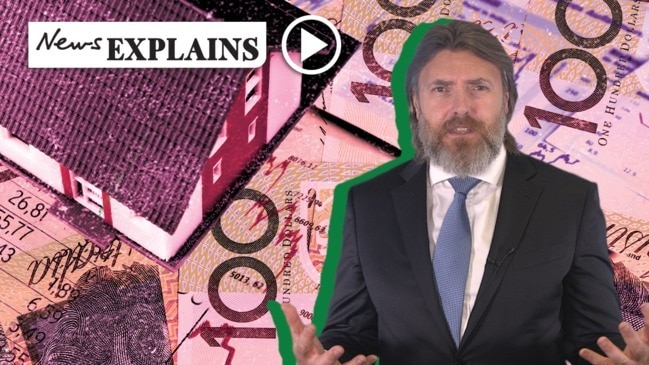Terry McCrann: Why the clock is ticking on the big market boom
Be concerned. The Aussie share market is booming — and at a record high — while the economy is struggling. That’s not normal, and it won’t end well. Terry McCrann explains what’s unfolding.

Share markets are booming while economies are tanking — all over the world.
Our market yesterday finally, finally, topped its previous all-time high, which had been reached just under 12 years ago, or almost a full year before the Global Financial Crisis erupted in September 2008.
I and I am sure former prime minister Kevin Rudd remembers it, the GFC, only too vividly — just like those of us old enough to remember the Moon landing and even older baby-booming fogies remember the Kennedy assassination.
Rudd remembers because he was almost literally “there” — at the very centre of the bubbling financial cauldron when it spilt over: Wall Street.

Just as seven years earlier, another Australian PM, John Howard had also been “there” on 9/11: In Washington.
In Howard’s case he was , literally, there in Washington when the planes hit; in Rudd’s case he was still in Canberra at the first eruption, but was soon in New York and Washington as the cauldron kept bubbling over.
In any event, in both cases, “being there” had consequences — practical policy reactions and arguably overreactions.
The first took us into Afghanistan and Iraq. The second led to the massive fiscal stimulus of “go hard, go early and go to households”, and a decade of Budget deficits.
Now, in July 2019, our market — at least as measured by the “All Ords”, the index purports to measure the entire market — finally hit a new closing high yesterday.
The more analytically meaningful ASX 200 — the index of the 200 biggest stocks and so almost all the total market capitalisation anyway, and the stocks which have the liquidity for in-depth trading — is still around 100 points off its (also pre-GFC) all-time high.
Yet our booming market is in sharp contrast to the struggling economy.
We’ve had three successive quarters of, and there is no other word for it, pathetic (barely) growth in the economy.

It has been, successively, 0.3 per cent, 0.2 per cent, and 0.4 per cent. That all adds to an annualised rate of just 1.2 per cent — when we would consider 3 per cent as the barely reasonable growth minimum.
The next growth figure, for the June quarter, surfaces early in September. It is most certainly not going to surprise us on the upside.
Trust me: We are not going to find that we had been ambushed by an economic boom and nobody happened to notice.
Growth for the full 2018-19 financial year will come in under 1.5 per cent — and almost all of it will be thanks to booming mineral exports.
That’s the pathetic overall number. It’s worse, much worse, when you allow for the (ridiculously, utterly insane and just plain stupid) high population growth.
GOING BACKWARDS
In per capita terms, we’ve actually been going backwards. Those “growth” figures are minus 0.1 per cent, minus 0.2 per cent and zero (at least not a minus but not a plus either).
In more “normal” times it would have been considered impossible to have a booming share market and a sluggish (at best) economy.
Booming markets and booming economies go together, because share prices are supposed to be a multiple of the profits that companies make and companies are supposed to make their best profits in times of boom.
In economic downturns they tend to go broke.

Yet the current mix is entirely rational. On one level, our market is just following Wall St, so it’s really quite disconnected to what’s happening in the local economy.
That broad statement is subject to the companies — and the best example is the big four banks — continuing to at least make reasonable profits.
It’s also, frankly, disconnected to whatever our Reserve Bank does with its interest rate and, through that rate, what happens to actual rates in the economy.
Again, that is subject to the RBA rate not being totally out of whack with other central bank rates.
Wall St is once again near its all-time high. In its case, that all-time high was set only last year. And it’s nearly double its pre-GFC high.
So what explains the difference between their boom boom and our very reluctant rise?
Broadly three things. Plus an overarching fourth.
Firstly, there are the FAANG+M stocks they have and we do not. They have Apple, Amazon and the old Microsoft, with each of the three worth around $US1 trillion.
That’s $1.4 trillion in our money; so those three stocks alone are worth nearly double, yes double, the worth of the entire, yes entire, Aussie market. Then add Facebook, Netflix and Google.

The second factor is the much stronger — compared with us — US economy.
And the third factor is a Fed (their version of our RBA) which will promise to cut interest rates and indeed will actually cut if the market stumbles or even just threatens to stumble.
Our RBA has never done anything remotely similar; and indeed it would simply not enter the head of current RBA governor Philip Lowe — or any of his predecessors.
It would also, not exactly incidentally, be irrelevant and pointless anyway.
MORE: TERRY McCRANN’S COLUMNS
Right now Wall St is wallowing in the best of all possible worlds. Interest rates about to be cut — which makes shares relatively more valuable. And the US economy is doing OK and so boosting corporate profits — which also makes shares more valuable.
And thanks to Wall St having the best of all possible worlds, our market has been dragged higher, quite unrelated to anything happening here.
It all comes down to that fourth factor — the tens of trillions of dollars of loose money sloshing around global markets looking for some sort of yield.
It is not normal. It cannot last. It will end badly.



